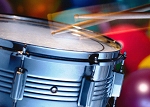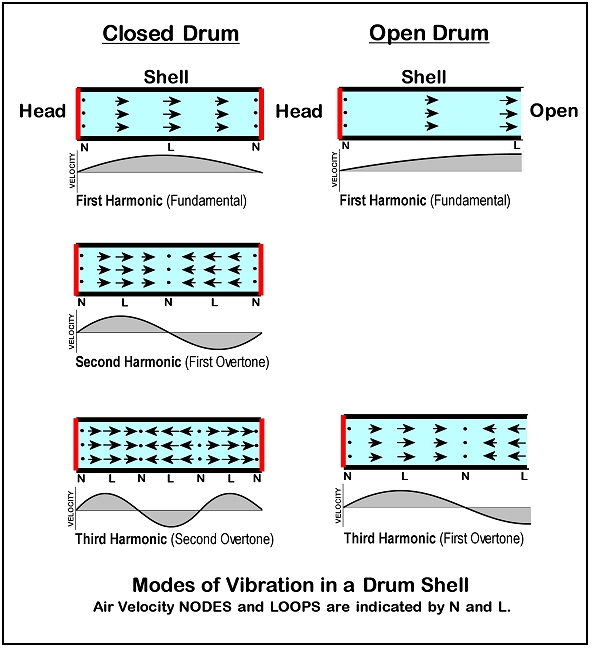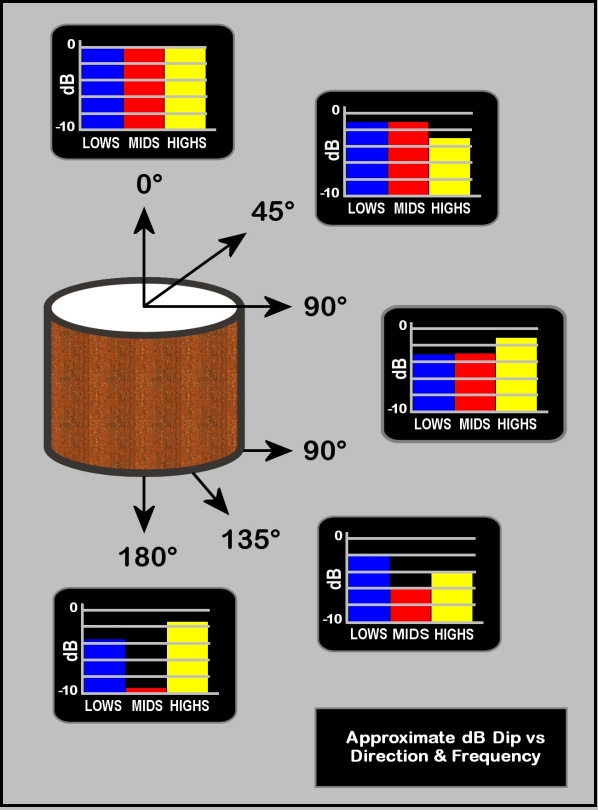
|
Drum
Acoustics
& Mic'ing
|
|
|
Introduction
|
|
A drum is a cylindrical shell surrounding a column of air, plus one or
two stretched membranes (drumheads).
Conga and timbral drums are variations of the basic drum, using curved
shells or bowls to create tonal resonances.
|
|
The Drumhead
|
|
When a drumhead is struck, a vibratory pulse travels outward from the
struck point. It travels in all directions toward the rim of the
shell, from which
it rebounds again and again.
In this way, a standing wave is set up on the drumhead
surface. The component frequencies depend on the diameter of
the drum, as well as the mass and tension of the drumhead.
The standing wave is a combination of frequencies that are not harmonically
related—that is, the overtones aren't related to the fundamental by whole
numbers, as they are in a string, pipe or tube.
Nodes and
Antinodes
Nodes are areas of no movement in a standing wave. Along a
1-dimensional string, nodes are points, as illustrated by red dots in
the following animation :

Anti-Nodes, also called Loops, are areas of maximum
movement in a standing wave. They're the opposite of nodes.
On the 2-dimensional surface of a drumhead,
nodes are lines, either a circle or a diameter :
Fig. 1 - Drumhead Overtones
|

|
In 3-dimensional space, nodes are surfaces and encountering one in a listening room is
called hitting a dead spot.
|
|
The Drum Shell
|
|
A drumhead, like a guitar string, makes very little sound all by
itself. Its shell, like a guitar body, completes the instrument.
The shell, besides serving as a rigid boundary for the head,
contains a column of air that can absorb vibrations at lower pressures
(higher volume velocities) than those existing on the drumhead.
By coupling the high, mechanical impedance of the drumhead to the
lower, acoustical impedance of the room, this column of air efficiently
transfers power to the room.
The shell, whether closed off with one drumhead or two, serves as a
cylindrical cavity resonator. The depth of the shell
determines its fundamental wavelength (the first harmonic).
If the shell is closed on both ends, the fundamental wavelength
(symbol lambda λ) is
twice the shell's depth (ignoring end effects) and all the harmonics
are present. The same is true of an organ pipe that's open on both
ends.
So, the fundamental wavelength of a closed, 12-inch
deep drum shell is 24 inches (2 feet). That corresponds to a frequency
(symbol f) of
550 Hz [f = c / λ
where c = speed of light ]. In addition,
all the harmonic frequencies are present,
for example: 2 x 550 = 1100 Hz; 3 x 550 = 1650 Hz; 4
x 550 = 2200 Hz; etc.
On the other hand, a shell that's open on one end corresponds to an
organ pipe that's closed on one end. The fundamental wavelength is
four times the shell's depth and only odd harmonics are present.
So, the fundamental wavelength of an open 12-inch deep drum
shell is 4 feet (275 Hz) and only the odd harmonics are present, for
example: 3 x 275 = 825 Hz; 5 x 275 = 1375 Hz; etc.
Fig. 2 - Standing Waves in a Drum Shell
|

|
So, an open shell has a lower fundamental tone than a closed shell by a
factor of two but only half the number of resonant harmonics. In
other words, it has lower pitch but a thinner, less harmonic sound.
But there's another another difference. Open shells respond
faster during both attack and decay. That's because less standing
wave energy is stored in an open shell. So the open shell
produces a
shorter, louder pulse of sound.
|
|
Drum Radiation
|
|
A drum's harmonic shell and non-harmonic drumhead are coupled into an
instrument that radiates like an acoustic dipole. As air
escapes from the top of the drum, it enters from below, and vice versa.
The drumhead or diaphragm of air that terminates the shell is called a
piston. As pressure waves within the shell stop and reverse
direction, the streams of air in progress from the top piston to the
bottom piston are pinched off and radiate outward.
The directionality of the radiation is complex, due to amplitude and
phase differences between the vibrations taking place at the top and
bottom pistons. But since the mean distance between the pistons
doesn't change, those differences depend entirely on the vibration's
wavelength. As a result, directionality depends on frequency.
|
|
Inside The Drum
|
|
The sound of a drum is severely defeated by using a microphone placed
inside the shell.
The vibrating piston of air at the shell's opening is what pushes off
the energy contained in the drum. Inside, standing waves store energy
in a stationary pattern of nodes and loops which don't travel and don't
impinge upon the mic. The mic's diaphragm will resonate if it happens
to be placed at a loop, but this generates a strong back EMF that
impedes the signal.
In addition, the acoustic impedance inside the shell is high compared
to that of free air, the source into which microphones are designed to
operate. So, inside a drum, a mic generates less power.
For both reasons, amplifier efficiency is compromised and clarity is
reduced across the board.
If a special effect is desired, or if extra frequency compensation is
needed, the mic may be tilted or moved to the back side of the drum to
achieve it. This is far superior, in a kick drum for instance, than
moving the mic inside. Nothing desirable can be achieved inside the
drum that can't also be achieved outside.
|
|
Directionality vs. Frequency
|
|
The major line of directionality for the sound of a drum is out the
cylinder's axis, at the struck end. All frequencies are their most
intense along this axis. A mic aimed as close as possible to straight
at the struck head will provide the strongest signal, and a strong
signal will withdraw fewer watts from a PA's limited reserve.
Low drum frequencies are the least directional, although experiments
show them dipped by several dB at 90° to the main axis and also out the
back (180°).
At around 45°, the middle frequencies are likely to have a secondary
peak, but the highs will have a dip there. The highs have their
secondary peak around 90° and also out the back.
The mids are the most directional. They dip by several dB at 90°, by
several more at 135°, and by almost 10 dB straight out the back.
At 135°, the highs have another dip before peaking straight out the
back or bottom (180°). There's an overall left-right symmetry, so the
pattern on either side of the main axis is the same.
Fig. 3 - Directionality of Drum Radiation
|

|
|
|
Microphone Placement
|
|
Since the mids are so unavailable out the bottom of a drum, top mic'ing
is usually preferable on floor and rack toms, pedal-side mic'ing on
kick drums.
On a kick drum, pedal-side mic'ing requires that the mic be placed near
the edge of the drumhead. On toms and snares, the drummer's swing can
impose the same requirement. Despite the mic's off-centeredness, the
axis of directionality remains perpendicular to the drumhead.
Although edge mic'ing may detract somewhat from the high end, tilting
the mic toward the drum's center won't improve the situation; a 45°
tilt always means a dip for the highs. A 90° tilt would seem a better
compensation for edge mic'ing, although a few dB of mids and lows will
be lost.
|
|
Kick Drums
|
|
Kick drums are sometimes given two microphones. One may be placed on
the pedal side, tilted at about 45° to concentrate on the mids and
lows. The other can be aimed straight at the back of the drum's center
to pick up the strong high frequencies there.
The back drumhead is called the resonator, or reso head.
The struck drumhead is called the batter head. Over the
years, the popularity of ported resonators has increased.
These heads have a 3 to 5 inch circular cutout that gives the drum a
low-frequency resonance. The drum's internal pressure pushes air out
of the port, creating a vacuum in the drum, sucking the air back in,
recreating a pressure inside, and so on. This springy behavior is
called Helmholtz resonance.
Ported resonators produce a less sustained, more articulated low end.
A reso port can be close mic'ed either straight-on or at an angle, or
the drum can be mic'ed as though it weren't ported.
In a large venue with big subwoofers the low resonance might boom,
while in a small club or recording studio the short resonant burst
might be good.
|
|
Snare Drums
|
|
The directionality of the snare drum is no different than the other
drums. But the rattle of the snares is part of the sound and that's on
the bottom. In addition, rim shots are especially important.
Sometimes, snare drums are given two dissimilar mics to capture
different aspects of its sound. Personal taste, stand logistics, and
drum directionalities all help to arbitrate the placement of snare mics.
|
|
Cymbals
|
|
A cymbal is essentially a circular brass plate supported at its
center. The cymbal's mass, size, and taper determine its resonant
modes. Specially designed modifications can add to the cymbal's basic
sound – a center bell is very common – but, like a drum, the axis of
directionality is perpendicular to the center of the plate.
Most of a cymbal's vibrational energy lies above 8 kilohertz but the
fundamental clang tone is as low as 200 to 400 hertz. A high overhead
mic can pick up the shimmer from a number of cymbals but the clang
tones are weaker and will be lost. Close mic'ing is needed to pick
them up, and the bell is a good target.
Clang tones are especially important to ride cymbals that elaborate or
fill in the beat. Crash, splash, and special effects cymbals are more
exclamatory and require less articulation.
High hats are more complex. Besides vertical radiation from the
plates, there are multiple reflections between the cymbals, driving out
sound horizontally. Mic'ing choices are abundant and will be
determined in part by stand logistics and by ear. Cowbells and other
percussive effects can also be mic'd.
|
|
In A Nutshell
|
|
The number of mics is always limited. Too many mics interfere
acoustically and lower the feedback threshold. On the other hand, some
mics can serve double duty.
A tom mic, for example, could be raised to include the clang of a ride
cymbal, while an overhead mic singles out the shimmer from all the
cymbals. Or a single mic could be used for two toms by raising it a
bit higher.
All in all, drum kits are quite complex. A good mic'ing arrangement
will take some time and experimentation to perfect and will vary from
kit to kit. The acoustics of the stage area will then determine the
final adjustments that are made.
|
|
|


